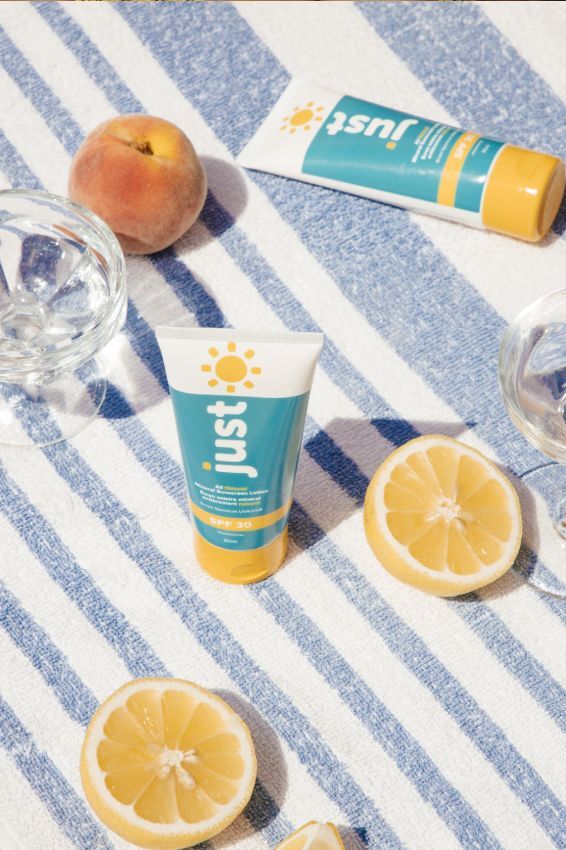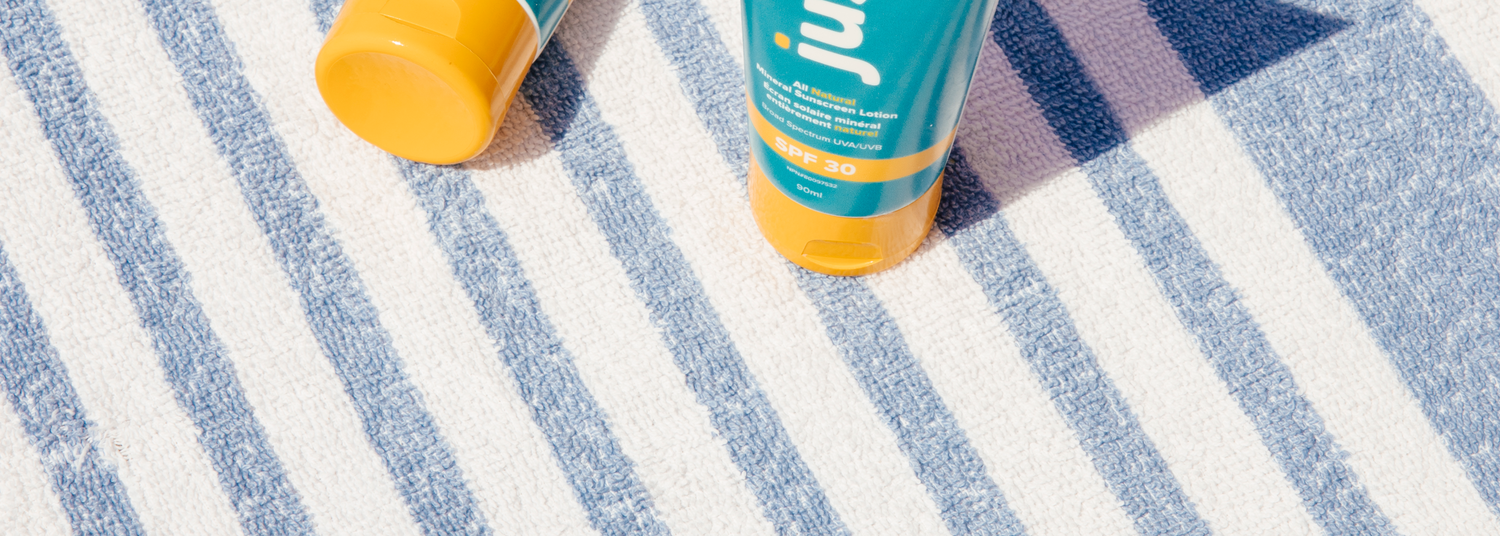Why Sun Care Matters Most for Children

The first fifteen years of a child’s life is when they’re most vulnerable to UV Radiation
May is national sun awareness month, which makes for a perfect time to improve our knowledge and strategies about sun safety, so we can get out there and enjoy the sun, worry-free.
Spending countless hours in the sun was always one of my favourite pastimes. Until recently, that is, when I learned that I needed to take a more serious look at the dangers caused by UV radiation. It was something my dermatologist mentioned at my last visit that got my ears perked up. She informed me about the significance of early protection from UV radiation, and that the first fifteen years of a child’s life are the most important. Children tend to be most at risk because their skin is very sensitive and very easily burned. Burns are a major contributing factor to the development of skin cancer later in life. Skin cancer is the most common cancer worldwide, with growing numbers annually. Let’s take an in-depth look over what some of these concerns are, and put together a sun-safe plan.
Here Are the Facts, And What Can We Do.
The stats I have discovered are astonishing! The skin cancer deal is real, with 9,500 cases diagnosed daily in the US. There are two different types of skin cancer, Non-Melanoma and Melanoma. Non-Melanoma includes Basal Cell Carcinoma and Squamous Cell Carcinoma. Basal Cell Carcinoma (BCC) is the most common form of skin cancer, and the most frequently formed out of all cancers. BCC occurs when DNA damage from UV exposure occurs. Squamous Cell Carcinoma (SCC) is the second most common type of all skin cancers with 15,000 deaths each year in the US, which is double that of Melanoma. Wearing an SPF of 30 can reduce your risk of developing SCC by 40 percent. Melanoma is the most deadly form of skin cancer and is on the rise, with a 47 percent increase in the past decade between 2010 – 2020. An estimated 196,000 cases of Melanoma will be diagnosed this year in the US. This is serious news!
The following factors increase your risk for developing skin cancer.
-
Unprotected, or excessive UV exposure
-
Fair Skin
-
Family history of skin cancer
-
Indoor tanning
-
Male gender (males are more likely to develop BCC or SCC)
-
Weakened immune system
-
Over 50 years of age (BCC, SCC)
Reports show that early protection from a young age is vital and that the most vulnerable time of our lives for sun damage is during childhood and adolescence. So this makes it the most critical time to protect for the future.
Sunburns during childhood are strongly associated with developing skin cancer later in life. They are the leading cause for the majority of cases of skin cancer. The risks of developing a melanoma more than doubles when there is a history of five sunburns or more, or just one blistering sunburn in childhood or adolescence. No matter how mild, any reddening on the skin is a result of DNA damage as a result of the effects of UV radiation. In fact, cellular damage can occur from sun exposure to skin that is tan or darker skin tones, without any signs of reddening. You won’t necessarily feel the damage that is being caused on unprotected skin.
Children’s skin is more sensitive than adult skin because natural skin protection systems are not fully developed. Their skin is more susceptible to burns which makes them more vulnerable. With this knowledge, it’s easy to see how kids are easily prone to sunburns, or cellular damage from playing outside or being in the pool. Kids tend to spend more time outside than adults, and reports show that most of our sun exposure occurs before the age of 18.
Another overlooked aspect is outdoor sporting activities. Kids spend lots of time taking part in after school and weekend sporting activities that take place outside. It is essential to protect their skin, from springtime, to fall, even when it is cloudy out. 90% of the ageing process occurs from skin damage from the harmful UV rays. The rays absorb through the skin and mutate our DNA. Although premature ageing may not be a driving force for applying sunscreen to your kids during soccer practice, UVA rays that are present during cloudy days are also responsible for causing certain skin cancers. Getting in the habit of applying natural sunscreen daily is one way we can indicate the importance of protecting from an early age. Using natural sunscreen is a great option for children as they tend to be better for sensitive skin. Natural sunscreens are usually made with less harsh chemicals like zinc oxide or titanium dioxide which work by forming a reflective barrier on the skin. Conventional sunscreens use chemical UV filters which work by absorbing into the skin, and thus into our bloodstream. These chemical UV filters pose health risks, and have been associated with cancer, endocrine disruption or organ system toxicity.
What We Can Do
It’s easy to reduce the risk of skin cancer by practicing some simple sun safety measures. Here are some recommendations for daily protection.
-
Daily natural sunscreen with a Broad Spectrum 30 SPF – It is important to have daily, year-round protection, even when the sun is hiding behind clouds. UVA rays penetrate windows, so protection while indoors is also indicated.
-
We recommend wearing a natural sunscreen to avoid your body absorbing harsh chemicals from the conventional kind. Recommendations suggest that we use one ounce of sunscreen per adult body, which is the size of a shot glass.
-
Sunglasses - Wearing sunglasses protects against harmful UV radiation, which can cause eye problems like cataracts.
-
Hats & Sun Protective Clothing – Use wide-brimmed hats for maximum coverage, and sun shirts and clothing to cover exposed skin.
-
Limit Sun Exposure. The hottest and most intense time of the day is between 11-3 pm. It’s not always practical staying out of the sun during those times, so maximize sun care if you are.
-
UV index - Checking the UV index is another source for monitoring how intense the sun is. Any weather app will provide this information.
-
Stay hydrated - Keep your skin and body hydrated with lots of water, replenishing electrolytes when appropriate. The sun is quite taxing on the body, so it’s important to rehydrate.
-
Shade – Plan activities in the shade as much as possible. Involve school-aged children by teaching them about the shade test. When the sun is directly overhead, it's rays are the strongest. If your shadow is shorter than your body, it’s time to maximize sun protection. Tip: Carry a beach umbrella in your car in the warmer months, and then you’ll always have some shade with you!
-
Remember that children need protection when they are on field trips, outside at school, and after school activities from spring until fall, even during cloudy conditions.
-
Educate your kiddos. I know mine can fight the sunscreen process, and they don’t fully comprehend why it’s so essential, so here’s a cute little video to help them see what the fuss is all about. https://www.youtube.com/watch?v=EwyqaLnsi5Q
I've started putting a natural sunscreen in the kid's bathroom so that they can apply some daily to their face, neck and arms.
Special Consideration For Babies
Babies are not born with a developed skin defence system and have thinner skin, so they are at a higher risk for burning. A sunburn for a young child is considered more dangerous as their skin to body mass is much greater. It is advised to keep small children under the age of one out of the sun, but if they are over six months of age, they can have sunscreen applied to areas that are not covered. A sunburn to a child under the age of one is considered an emergency. Contact your doctor right away if this happens.
*References and Informative Sites To View.
-
https://www.skincancer.org/skin-cancer-information/skin-cancer-facts/
-
https://dermatology.ca/public-patients/sun-protection/world-melanoma- (Association)day/
-
https://dermatology.ca/public-patients/sun-protection/sun-safety-every-day/
-
http://www.safecosmetics.org/get-the-facts/chemicals-of-concern/benzophenone/
-
Pustisek, Nives et al. “Acute skin sun damage in children and its consequences in adults.” Collegium antropologicum vol. 34 Suppl 2 (2010): 233-7.
-
Kleier, Jo, et al. "Sun Exposure and Protection Practices Of Caregivers for Young Children Living In South Florida." Pediatric Nursing, vol. 43, no. 3, Anthony J. Jannetti, Inc., May 2017, p. 138.




